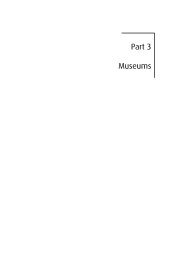Charting the Sensorial Revolution - David Howes
Charting the Sensorial Revolution - David Howes
Charting the Sensorial Revolution - David Howes
Create successful ePaper yourself
Turn your PDF publications into a flip-book with our unique Google optimized e-Paper software.
Senses & Society<br />
120<br />
Book Reviews<br />
With La mesure des sens by Nélia Dias we move from eighteenthcentury<br />
to late nineteenth century France, and witness <strong>the</strong> emergence<br />
of cerebral topography as a new paradigm (in place of “sensibility”)<br />
for conceptualizing <strong>the</strong> operations of <strong>the</strong> senses and <strong>the</strong> intellect. The<br />
scene here is one of <strong>the</strong> senses – or <strong>the</strong>ir representations in scientific<br />
discourse – being rigorously labeled and ordered so as to conform<br />
to contemporary scientific and social models. Basing her analysis on<br />
<strong>the</strong> proceedings of <strong>the</strong> Société d’anthropologie de Paris (SAP) during<br />
<strong>the</strong> period 1859–1890, Dias brings out how <strong>the</strong> supposedly objective<br />
categorizations of <strong>the</strong> senses undertaken by physical anthropologists<br />
and physicians were in fact rife with culturally-based assumptions.<br />
For example, just as <strong>the</strong> left hemisphere of <strong>the</strong> brain was held to be<br />
superior to <strong>the</strong> right and <strong>the</strong> frontal lobes were considered superior<br />
to <strong>the</strong> posterior lobes, <strong>the</strong> senses of sight and hearing were grouped<br />
toge<strong>the</strong>r and deemed to be superior to <strong>the</strong> senses of smell, taste<br />
and touch. Fur<strong>the</strong>rmore, <strong>the</strong> latter, inferior, senses were associated<br />
with “inferior” social groups – namely, women, workers, “primitives”<br />
and “idiots.” It is evident that what was held to be a sensory anatomy<br />
was, in fact, a social anatomy, and one undertaken from a particular<br />
cultural perspective – that of <strong>the</strong> bourgeois man of science.<br />
Generally speaking, “primitives” were assumed to have greater<br />
sensory acuity than civilized, rational Europeans, particularly with<br />
regard to smell, taste and touch. The anthropologists of <strong>the</strong> SAP – and<br />
of similar organizations in o<strong>the</strong>r countries (see <strong>Howes</strong> 2003: 3–6)<br />
– were determined to give scientific authority to this assumption by<br />
measuring <strong>the</strong> sensory capacities of indigenous peoples. One of <strong>the</strong><br />
issues debated within <strong>the</strong> SAP was how this could be accomplished<br />
with due scientific rigor and objectivity. Distrusting <strong>the</strong> judgment of<br />
<strong>the</strong>ir own subjective senses, <strong>the</strong> anthropologists relied on a series<br />
of instruments from <strong>the</strong> ophthalmoscope to <strong>the</strong> es<strong>the</strong>siometer for<br />
<strong>the</strong>ir sensory measurements. They also devised a series of protocols<br />
of observation designed to neutralize <strong>the</strong> “personal equation,” such<br />
as determining la bonne distance from which to gauge <strong>the</strong> color<br />
of <strong>the</strong> iris (considered an essential marker of racial difference) and<br />
using Broca’s chromatic scale to record <strong>the</strong>ir judgments. Yet ano<strong>the</strong>r<br />
technique was to employ a questionnaire in which, as Dias notes, <strong>the</strong><br />
questions were so framed as to virtually ensure that <strong>the</strong>ir answers<br />
would support <strong>the</strong> paradigm of <strong>the</strong> greater sensory acuity of <strong>the</strong><br />
savage. Given that <strong>the</strong> senses in general were associated with <strong>the</strong><br />
life of <strong>the</strong> body ra<strong>the</strong>r than that of <strong>the</strong> mind, <strong>the</strong> supposedly keen<br />
perceptions of indigenous peoples confirmed <strong>the</strong> cultural stereotype<br />
of <strong>the</strong> brute physicality of <strong>the</strong> savage.<br />
The models generated by such research were not simply speculative<br />
in nature but were put into practice by <strong>the</strong> French government<br />
in order to police and promote <strong>the</strong> “sensory hygiene” of <strong>the</strong> peoples<br />
under its control. While Dias does not go into how <strong>the</strong> sensory<br />
measurements of <strong>the</strong> anthropologists were utilized by colonial<br />
administrations, she does describe how tables of sensory traits and



